The Moxon Brownes
Bob Moxon BrownePublished 2019
This online edition is a work in progress; captions here are tailored, and additional images are provided, for the Mahurangi Magazine audience
Chapter 2
Pages 23–39in printed edition
Octavius Browne
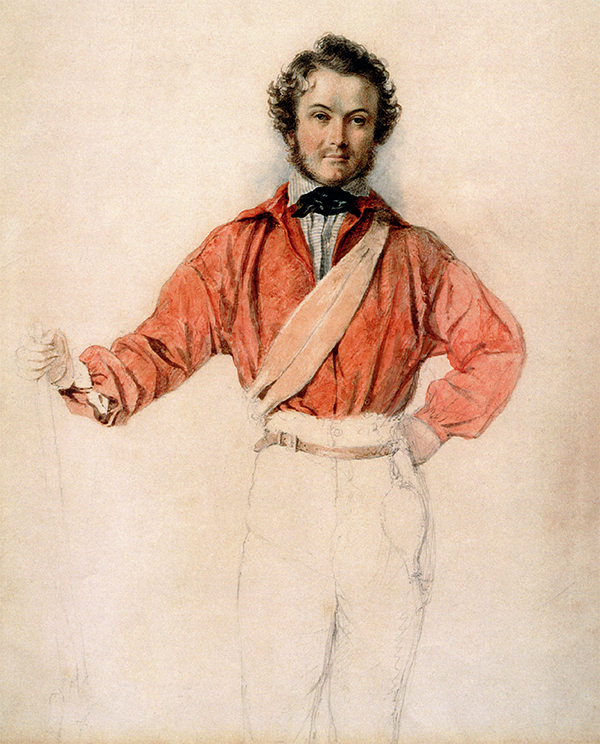
Octavius Browne 1809–1876: Painted by the redoubtable Georgiana McCrae, in Melbourne in the 1840s. Octavius is shown in “outback” rig. watercolour Georgiana Huntly McCrae
William Browne’s son Octavius Browne was born on 2 November 1809. Charles Gordon Browne says:
…the place of his birth and the date of his baptism is not known, but we have been told that just before he left Courtlands on the journey to Scotland in the course of which he died, he destroyed his baptismal certificate. Why he should have done so it is difficult to imagine, unless, as is quite possible, he may have been christened by a Roman Catholic priest at St OmerIt is correct that Octavius accompanied his mother and most of his siblings, including Kate, to Saint-Omer in 1814; but it seems unlikely that his family should have waited five
years to have him baptised, or should have seen any reason for him to be baptised in the Roman Catholic church.
Charles BrowneCharles Gordon Browne records that Octavius was sent to Merchant Taylors’ School, but:
…was starved and bullied into a dangerous illness and was removed after a short connection with that school and sent to a school in Suffolk—here he remained for some time, but the bills were not paid till he paid them himself when he began to get on in the world—presumably after his return from Australia in 1855It seems improbable that Octavius would have waited 30 or more years to pay his school bills. A note in Charles Gordon Browne, in a different hand, reads “The School was Botesdale under the Rev Wm Haddock. On January 9th 1823 Mr Haddock writes to Thos Moxon jn (Leyton ) acknowledging a payment on a/c of £39.1.6 and saying that there is a balance due of £119—and that Thos Moxon Snr will pay for (Octavius’s elder brother ) Septimus till Ladyday and for Octavius Thomas Moxon jn will pay until Midsummer …”.
The intervention of the Moxon family to pay Octavius’s school bills probably coincided with the sudden departure of Octavius’s father, William Browne, who deserted his family for the United States in around 1823. Charles BrowneCharles Gordon Browne continues:
At the age of sixteen and a half (i.e. in 1826In the same year, Octavius’ elder brother Gordon departed to seek his fortune in Australia.) [Octavius] was cast upon the world to make his own living and appears to have started in some office work with £100 p.a., which had to help to keep his mother and the younger members of his family, as well as himself. Where he began to work is not known to us, but it would seem most likely that one of the good Moxons helped him to a berth, as he would hardly at that age have been able to earn £100 per year.
As Charles BrowneCharles Gordon Browne indicates, nothing is known of Octavius’s initial occupation. Charles BrowneCharles Gordon Browne mentions that after Octavius’s sister Lucinda married Elhanan Bicknell (in 1829):
…he was a good deal at their house at Herne Hill, where for a long time he was persona gratissima. His sister called him “Octus” or “Oc” and in 1835 he went with Mr and Mrs Bicknell and Henry, a son of Mr Bicknell by his first wife, for a tour through France and Switzerland and Germany July 27th to September 24th.This journey is evidence of the closeness between Octavius and the Bicknell family at this time. However not long afterwards, there was what Charles Gordon Browne describes as a “final rupture” between Octavius and Elhanan. This may have been due to a business dispute, possibly arising out of Octavius’s trip to New Zealand and Australia, dealt with below.
It may be that Elhanan Bicknell, who was a very successful businessman, was giving Octavius some support at this time. What is certain is that in 1839, Octavius set out for New Zealand and Australia, probably with the intention of setting up in business in one or other of these locations, or at least exploring the opportunities for doing so.
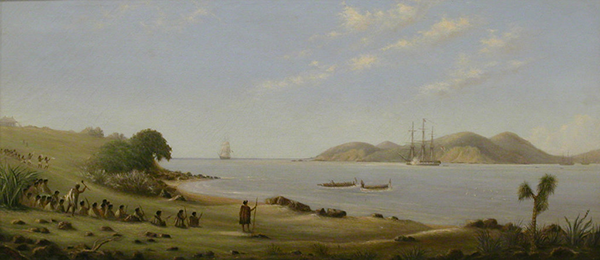
Similarly Idealised: Just as Georgiana McCrae’s portrait of Octavius Browne was praised as the idealised Australian settler, this idyll of Lieutenant Governor Hobson landing at Waitangi—painted 57 years after the event—would likely not have been quite as Browne recalled the Bay of Islands when he arrived there 14 weeks earlier. oil on canvas Matthew Clayton
Charles BrowneCharles Gordon Browne relates, rather peevishly, that Octavius was “induced” to visit New Zealand by his brother Gordon, but it seems more likely that Octavius was concerned about reports of Gordon’s declining health, and believed that a visit to him could be combined with prospecting for employment. It is known that Octavius brought trade goods—i.e. blankets, tools, mirrors etc intended for trading with New Zealand’s indigenous people—with him when visiting Gordon, which may indicate that he had quite firm intentions of setting up in business in the islands.
Octavius arrived in New Zealand’s Bay of Islands on 21 October 1839. Details of his subsequent adventures are The whole of this letter is transcribed in Charles Gordon Browne, who obviously believed it to be a document of some historical and/or geographical significance. There is also a copy in the Mercury Bay Museum at Whitianga in New Zealand’s North Island. described in a long letter subsequently written to his cousin Eliza Moxon at The Lodge, Twickenham, dated 3 February 1842, while at sea, when Octavius was en route from Australia to Calcutta.
After some days at the Bay of Islands, Octavius sailed south on a vessel called the Hope, which was bound eventually for Valparaiso. The Hope put in at Waihekein printed edition: Weihati Island at the mouth of the Firth of Thames to take on board firewood. Octavius here transferred to a small whaleboat, taking him across to Coromandel Harbour, where he stayed for a month in very primitive conditions. Describing what he found in his letter to Eliza Moxon, Octavius mentions attempts by Māori to provide him with a wife:
During my stay here a matchmaking lady paid me a visit with her three daughters, and made a dead set at me for a husband for one of them. The young ladies seemed to be very amiable, and not extravagant in dress—but not being in search of a wife I evaded the question, and made my presents in equal shares to the three girls so as to avoid the appearance of paying marked attention to one of them…
![Go to National Library of New Zealand: Heaphy, Charles 1820–1881, ‘View of the Kahu-Kahu Hokianga River’ [December] 1839 The Bolina, left, and the Francis Spaight](https://www.mahurangi.org.nz/wp/wp-content/uploads/2017/05/Bolina-Francis-Spaight-600.jpg)
Possible Transport: Octavius Browne travelled south from the Bay of Islands on a spar ship, possibly the Francis Spaight, being loaded by her bow ports, here, a little earlier in Kohukohu, Hokianga Harbour, or even the Bolina, astern, which took Gordon Davis Browne and Dacre to Mahurangi, in 1832. artist Charles Heaphy
In the same letter Octavius relates that from 2nd to 14th December 1839 he was onboard a ship taking on spars in various parts of the Thames Firth—probably with or on behalf of his brother Gordon. He gives details of a place he was “particularly pleased with” called Waiomu, south of Coromandel Harbour (today a popular beach resort) where he dined on “hot cockles, potatoes and water served in fresh cups of the flax leaf”, and received another proposal of marriage:
The old chiefcapitalisation of chief, captain, and missionary is normalised in this and following two quoted paragraphs paid me a visit on board ship one day with a young lady in a blue print dress and an old woman who seemed to act as Duenna. He squatted on the deck, and with much gravity and dignity proceeded to honour me with a long address—which being interpreted was to inform me that I was decidedly a “very nice young man” that he had taken a great liking to me, and that he meant to give me his daughter to wife, to build us a fine house, and give me a large quantity of his best land, if I would settle among his people. There was much propriety, and what we might call good breeding, in the chief’s language and manner—my intended, pardon my vanity, seemed “nothing loath” if I might judge from her “nods, and becks, and wreathed smilesHere Octavius is quoting from Milton’s poem Allegro, the odd ampersand spelled out”, and as for her elderly attendant she seemed by the approving looks she bestowed on “the young couple” to have made up her mind to the match.
I was really very much embarrassed by this offer of house, land, lady, for I saw the chief was quite in earnest, and his intentions kind—and I neither wished to offend his pride nor to slight the young lady’s feelings—a plump good humoured looking girl, but neither pretty nor a fine woman as we call those who are 6ft high and have a large nose—so I explained my sentiments to my interpreter and begged him to get me out of the scrape in the best way he could. He said something and the party took leave. Next day some young men come in a canoe to see Okitawio Paraonei.e. “Octavius Browne” and after much talking I found they wanted a copy of St Luke’s Gospel—when I told them I had none they asked if I was not a missionary, and I told them no.
They seemed puzzled, so was I, and went away—but the next day back comes the old chief with the gentle Juliet and Nurse to renew his proposals—for the captain’s bright idea of declining them before had been to say I was a missionary, and when the young men assured him I had said I was not, he thought there was some mistake, and came back to negotiate the union of our houses again!
Octavius continues that on 23 December 1839 he visited the missionary station of Mr William Fairburn at Maraetairendered Maraetari in printed edition, south of Waiheke Islandin printed edition: Weihati Island and Mercury Bay, where Mrs Fairburn:
…very kindly made me a present of an excellent ham and a couple of forks … I had only a pocketknife for killing, cooking and eating till now…
![Go to National Library of New Zealand: King, Marcus, 1891-1983 [The signing of the Treaty of Waitangi, February 6th, 1840]. 1938 Marcus King, 1938](https://www.mahurangi.org.nz/wp/wp-content/uploads/2020/03/Treaty-Signing-600.png)
Silent on the Signing: Sadly, although at times a prolific letter writer, Octavius Browne left no written account of the 1840 signing of the Treaty of Waitangi, New Zealand’s founding document, which he happened to witness, although the scene bore scant resemblance to this shamelessly Pākehā-elevating romanticization. artist Marcus King, 1938
From Maraetai, Octavius sailed in company with his brother Gordon to Waiheke Island, where on 24 December, Gordon paid off his local Māori workforce, under the control of a chief called Ruine. Octavius describes a disturbing scene of Gordon recklessly distributing Octavius’s stock of trade goods to the Māori, “quite unconscious that they were mine, or of the loss he was inflicting on me”—an early indication that Gordon’s mental state had begun to deteriorate.
Octavius returned with Gordon to Mercury Bay, where he stayed until 24 January 1840, before leaving for the Bay of Islands. That journey north took eleven days in poor weather, with Octavius and his Māori crew foraging for provisions on the way. Octavius gives Eliza quite detailed descriptions of the food he had to eat, and of a narrow escape from a meal of “very highly flavoured porpoise” which his crew were enjoying. Octavius preferred pork:
Within an hour, I who a few months ago would turn away my eyes from a butchers or sausage shop in London had actually slaughtered, cooked and eaten swine flesh … I fell into a long train of thought on the origin of cannibalism …
Octavius put into the Bay of Islands, rowing the last stretch against a contrary wind, on 4 February 1840. There he found hms Herald, with Captain Hobson, who was hosting a large number of Māori chiefs who had assembled for the negotiations leading to the Treaty of Waitangi, the founding document of New Zealand’s sovereignty. The treaty was signed on 5 February 1840. Octavius attended the negotiations, but sadly his letter to his cousin Eliza is silent as to what happened. All he says is:
A report of this day’s proceedings would be interesting but rather a long tale, and if I don’t leave [these reminiscences ofSo far as is known, Octavius never gave any written account of this momentous occasion. The absence of an independent description of events is a loss to modern historians.] New Zealand soon I shall never get to Australia or Tahiti.
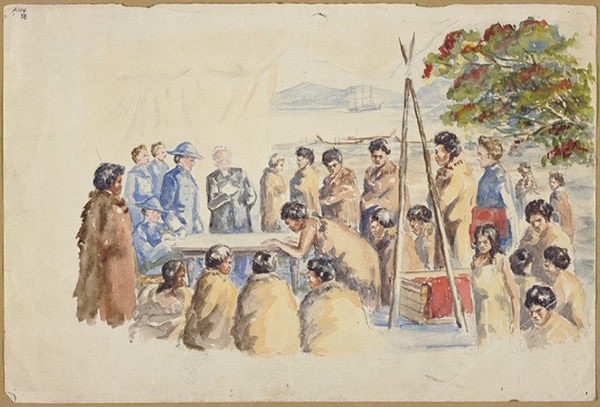
Closer to the Truth: In that no preparations had been made for a grand signing on 4 February 1840, and that Lieutenant Governor Hobson was caught, other than his ceremonial hat, sans-uniform, this early depiction of the founding event was, aside from the unseasonably late-flowering pōhutukawa, a far more faithful attempt. William Hobson and Gordon Browne both experienced great privations and both died young, although the former lived to 49, as opposed to Gordon’s 40, or contrasted to Octavius’s 66, years of age. watercolour possibly Oriwa Tahupotiki Haddon
Octavius left New Zealand a few days later, bound for Sydney, Australia, with—in his words to his cousin Eliza—“all my plans completely destroyed—a great loss of money, and nothing but care and trouble before me”. Octavius does not elaborate on the source of his disappointment, but it seems clear that he did have more than a casual interest in settling in New Zealand, or at least doing some business there, and that his plans were frustrated. This may have been due to the difficulties he encountered resulting from his brother’s deteriorating mental state, and confused financial affairs, as discussed in Chapter 9, dealing with Gordon’s life; or possibly some quite separate venture which he did not want to discuss with his family.
Having dealt with his time in New Zealand, the second half of Octavius’s long letter to his cousin Eliza is devoted to his adventures in Australia, and particularly his travels on horseback over a distance of about 500 miles into the bush, north of Sydney. Octavius says nothing in this letter about life in Sydney, or what his purpose in visiting Australia was, but it is evident that, after his disappointments in New Zealand, the idea of squatting on some land and raising sheep or cattle did cross his mind, although he evidently decided that the hard and lonely life of a pioneer rancher was not for him. His descriptions of life in the bush are picturesque, but he is unsparing in his details of the harshness of the bushman’s existence, and the total lack of amenities, or what he calls “society”.
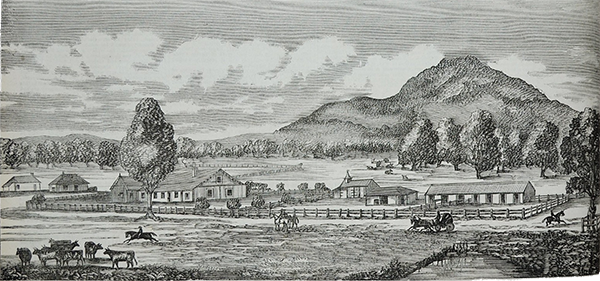
By the River Namoi: This 1870s depiction of Diniwarindi Station is presumably of a landscape much modified in the intervening three decades since Octavius Browne determined that life as a squatter anywhere along the Namoi River was not his cup of billy tree. etching Australian Town and Country Journal
Octavius gives a picture of a cattle station on the plains by the Namoi Riverin printed edition: River Namoi, about 420 miles north of Sydney:
[Sketch of a cattle station in NS Wales—Plains 1 mile from the R. Namoi a ridge with pine trees something like Scotch fern. Huts of pine trees and bark.] This is meant for a view of a station in the bush—on a large scale belonging to English gentlemen squatters—this is the third place they had made in 3 years—the deluge drove them from the first with great loss—drought and the savages, who speared many of the cattle and two of their men, gave them notice to quit a second—and here they had set to work again with 1300 head of cattle and about 30 miles of water frontage for the boundary of their “run”—distance from Sydney 420 miles—drays sometimes six months going and returning with supplies of flour, tea, sugar etc. letters received once a year. Superintendent a young man educated for the bar, son of a general.
His dress is a red or blue shirt—stockman’s trousers patched with leather—boots never blackened and any queer thing for a hat—his teeth are blackened with incessant smoking, his sunburnt face overgrown with hair, for brushes and razors are seldom seen in the bush, and clean linens or skin are rarities. His occupation is among cattle, his companions convicts and half savage Irishmen who plague him from morning to night—he eats beef and damper (when he has flour) 2 or 3 times a day—drinks tea at and between these meals by the quart, and smokes, sometimes chews, a vast quantity of Negro headBlack Virginia tobacco soaked in molasses. At night he rolls himself in opossum skins or blankets full of dirt and fleas, and lies by the fire in his hut or on a stretched hide or a sheet of bark. One day is as like another as two drops of rain—no society no books—rarely a letter—the same objects surround him—the same monotonous ideas stupefy and sadden him—and this life in the wilderness, which is not without its charms at first, becomes at last almost insupportable as the realities of emigration dispel the illusions of imagination.
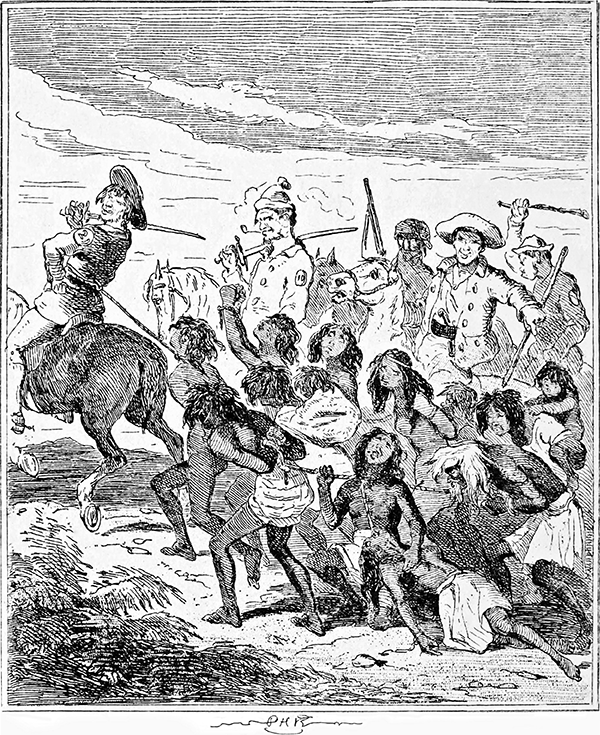
Nephew’s Depiction: Nephew of Octavius and Gordon Browne, Hablot Knight Browne aka Phiz’s Chronicles of Crime illustration of the Myall Creek Massacre, in which at least 28 aboriginal people, including old men, women and babies, were murdered by Australian settlers. In a trial taking place just before Octavius arrived in Australia, seven men were convicted of this atrocity and hanged. etching Phiz
Very shortly before Octavius’s arrival in Australia, the genocide of the aboriginal people was being actively encouraged by the colonial governments across the continent. As late as the 1830s, bounties were offered of £5 per aboriginal adult, and £2 for a childSee Stockton: Australia’s Centuries-Long Genocide Against Aboriginal People (2016)..
However, following the election of a Whig government in the United Kingdom in 1830, and the consequent abolition of slavery in 1833, things began to change, and by the time of the famous Myall Creek Massacre in 1838, settlers were actually being prosecuted—and in some cases hung—for the murder of aborigines. Arriving in New South Wales in 1840, Octavius was in time to observe reactions to the new laws. Speaking of an encounter in the then very remote and isolated Liverpool Plains, to the north of Sydney, Octavius recorded:
Next day—an old convict for our host seemed very melancholy about the prospects for the Colony—very indignant at the prohibition to murder Natives:
“We’d soon clear the country on ’em Sir if the Governor would just leave us alone for six months—I remember the time Sir when we used to shoot ‘em just the same as so many Dogs, the varmint and I s’pose I hasn’t settled less than 60 on ’em first and last myself. They ain’t a going to prevent my getting rid on ’em now, for if I catches them Black Devils a spearing my master’s cattle I’m d-d if I don’t do for ‘em—but I shan’t say nothing to no-one about it, and if there was any feller black or white see’d me do it as I thought would peachinform the authorities, or in modern slang, “grass”, I’d settle him too. When they come to the hut begging give ’em a damper with a good lot of arsenic in it Sir, that’s the way to serve ’em.”
All this was addressed to one of my companions, an old gent and a magistrate, but a new man in the colony. As we lay down I said to him, I think as a J.P. Sir you might have reproved that rascal. “The less we say the better, I think”, he replied. “I dare say you are right, I added for this seems a very likely place for a man to get up in the morning with his throat cut. Travelling here makes a man acquainted with strange bedfellows.
Octavius’s eventual conclusion was that there were no longer real opportunities to make money as a sheep or cattle rancher in Australia, and that in any event the life would not suit him. In setting down his reasons, at some length, it seems that Octavius was anxious to persuade his family in England that his decision was reasonable, and that if he had thought there was any prospect of his achieving financial independence as a rancher, he would have done so. The following is an abbreviated version of what he said in his letter to Eliza:
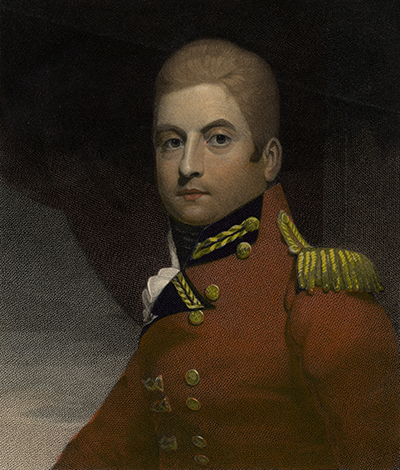
Gordon Connection: The origin of Octavius Browne’s brother’s given name Gordon is not known, nor was it by the nephew named for him. But given the dash cut by General George Duncan Gordon, 5th Duke of Gordon, Marquis of Huntly, and the subsequent friendship between his illegitimate daughter Georgiana Huntly McCrae, and Octavius, it would be delightfully symmetrical if the duke was the source of Octavius’s brother’s Gordon. engraving William Holl | artist Andrew Robertson
Gentlemen squatters while they have far more courage and contempt of physical privations than their ignorant men of bones and sinews who live to eat, cannot withstand the ill effects of a gradual oblivion of all the decencies of society, and the constant dearth of intellectual food. These effects are curious, varying according to the temperament and circumstances of individuals—but more or less demoralising in all cases—and quite enough to prove that men thus removed from a state of high satisfaction to one of rude freedom far from the haunts of their fellow beings, retrograde most rapidly towards barbarism. The condition of very many of the young men who have emigrated within the last 3 or 4 years to acquire a speedy independence as they hoped, by feeding sheep and cattle in the bush of Australia, is most melancholy. Formerly it is true the older colonists did make handsome fortunes very rapidly in this way—they had convict or slave labour for nothing—land given to them—they had no need to advance far inland for pasture, and as fast as their flocks and herds increased there was no want of purchasers to take them at high prices, nor of unoccupied lands for their support. In those days a man with two or three flocks of sheep had only to “sit down and grow rich” by their increase upon increase, and in seven years, if he did not kill himself with drinking, might from such a small beginning find his income 2 or 3000 £ a year—there was some temptation to a bushman then, and something to keep up his spirits. But now the case is very different: no grants of land—no assigned servants—immense distances to go, by which expenses risks and hardships are immediately increased—free labour so dear that the fleeces of a flock scarcely pay the shepherd’s wages—and as another consequence the value of the increase diminishes, while the amount of it is much less owing to more casualties and disease from want of sufficient shepherds and other causes. Thus in New South Walesrendered N.S. Wales: New South Wales among other anomalies you may see convicts worth £10000 per annum, and honourable gentlemen virtually transported for life by the fortune of sheep farming.
When my plans of settling in New Zealand were destroyed I made up my mind to squat, if I could satisfy myself that by converting the small sum I had left into sheep or oxen and living with them in the bush for 10 years I could hope to secure a “genteel independence” of £2 or 300 a year—but after travelling about 2000 miles in New South Walesrendered N.S. Wales: New South Wales and Australia Felixrendered Aust. Felix. Australia Felix: State of Victoria I could not find a peg on which “to hang a hope”, and to tell you the whole truth, I was not sorry (so far as I was concerned) that the prospect was so indubitably bad—for even were it much better I know that I am not “cut out” for a squatter … . I am by no means sorry therefore that I am no squatter, but I do regret that my plan of settling in New Zealand was destroyed, because while I can fully appreciate from experience all the deprivations and difficulties which it involves, I know that my labours were something in themselves to sustain my energy, and were likely to be rewarded with competence and the satisfaction of knowing that life had been well spent. Since however all these chateauxi.e. castles (in the air) have vanished into thin air, it is of no use to be thinking of them any longer.
Octavius concludes his letter to his cousin Eliza by explaining that he is bound for Calcutta, where he intended to travel to Madras to visit his brother Charles; but beyond that, he evinces no particular plans for himself.
This was evidently a low point in Octavius’s life. Although at several places in his letter to Eliza, he stresses that he is by nature cheerful, and keeps up his spirits whatever the adversities facing him, it is obvious that he was suffering some disappointment, both by his failure or inability to settle in New Zealand, and, perhaps less acutely, his realisation that he was not cut out to be a pioneer in Australia.
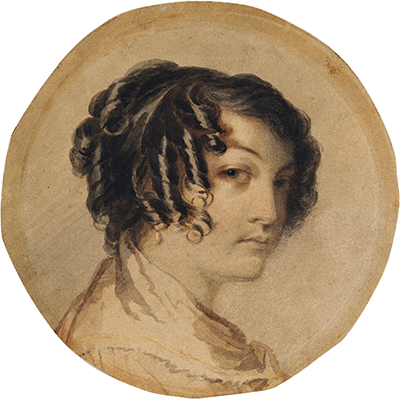
Captivating Capturer of New-Settler Irony: Self-portrait of Georgiana Huntly McCrae, who, in her portrait of Octavius Browne, was said to have captured “the ideal figure of a new settler: youthful energetic adventurous and hopeful of the future”, who, in fact, was quite as disabused of the attractions of settling as was his portraitist. watercolour and pencil Georgiana McCrae
Before leaving Australia, Octavius spent some time in Melbourne, where he may have been scouting out opportunities for some commercial employment. While there, in October 1841, Octavius had a three-quarter length portrait of himself painted by the newly-arrived emigrant to Australia, Georgiana McCrae, who records in her journal that the job was completed in three sittingsSee Georgiana’s Journal, Melbourne 1841–1865, Angus and Robertson 1934.
Georgiana was a talented artist, who was an illegitimate daughter of the Duke of Gordon. She had struggled to make an independent living in London, where the circumstances of her birth placed her at the fringes of fashionable society, but never quite part of it. While in London, Georgiana had been helped both with hospitality and introductions to potential patrons, by the Cummins family, who lived in a large house known as Mayfield Lodge in Stockwell in South London. Georgiana was a frequent guest at Mayfield LodgeSee “Georgiana” by Brenda Niall (1994), at p. 105. Georgiana was to name her house in Melbourne “Mayfield” presumably in tribute to the Cummins family, friendly with the head of the family, James John Cummins, his wife Lucia and daughter Martha. Octavius was subsequently to marry Martha Cummins, which suggests that he may have known Georgiana, or at least to have had an introduction to her, prior to his arrival in Melbourne; although it is possible that the introduction was the other way about, and that it was Georgiana who gave Octavius an introduction to Martha, which he pursued on his return to England.
Georgiana’s beautifully painted portrait of Octavius now hangs in Melbourne’s La Trobe Picture CollectionAfter Octavius’ death, this picture passed to Charles Gordon Browne, who left it to his daughter Gladys Monica, who had it in her possession until her death in 1960. She inscribed the back: “This portrait is to go to Paymaster Kendall Moxon Browne RN c/o the Admiralty (i.e. the author’s father).” However, the picture never came into his hands, reappearing in Australia in the 1980s., in Victoria’s State library in Melbourne. It shows Octavius in “outback rig”, described by Brenda Niall as:
One of Georgiana’s finest colonial works … representing the ideal figure of a new settlerSee “Georgiana” by Brenda Niall (1994), p. 280–281.: youthful energetic adventurous and hopeful of the future.
This was an ironic description. When the picture was painted, Octavius was despairing of a future in the colonies, and was on the point of returning to England with no money, and as confirmed by his letter to his cousin, no real plans for the future. Charles BrowneCharles Gordon Browne records, rather mysteriously, that on Octavius’s return to England, probably sometime in late 1842:
…he found himself much blamed by some of his relations, and indeed exposed to some unpleasant charges, so he wrote a paper to clear himself, which he called Octavius Browne’s account of his unaccountable conduct. A copy of this was found in [his wife’s] dressing case after [her] death where it was found by [her daughter] Geraldine and when she found the papers she believed her mother had meant her to find and destroy them to prevent further bitterness of feeling over an old quarrel—so without reading it she burnt it … whether any other copy is in existence is not known to the writer [i.e. Charles Gordon Browne] but it is much to be wished it may come to light somewhere, as it would settle matters which it is very inconvenient to leave unexplained.
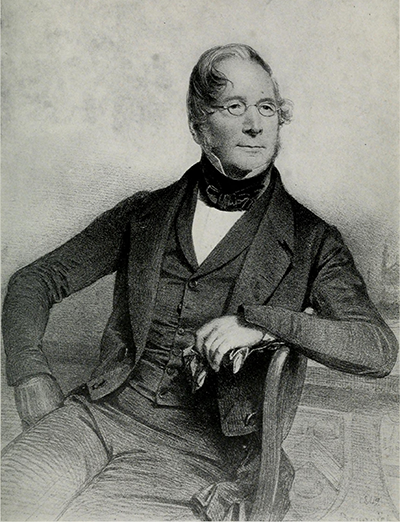
No Account of Unaccountable Conduct: Because Octavius Browne’s “account of his unaccountable conduct” was reportedly burned after his death, it may never be known whether it was connected the ending of friendship and association with his brother-in-law Elhanan Bicknell, businessman, shipowner, and patron of the arts. image Providence
Elsewhere Charles BrowneCharles Gordon Browne speculates that these “unpleasant charges” may have emanated from Octavius’s brother-in-law Elhanan Bicknell, whose former friendship and association with Octavius seemed to end at about this time. Elhanan Bicknell was a very successful and wealthy whale oil trader, who had interests in whaling vessels in the South Seas, whose voyages he underwrote in return for mortgages over the ships. He was also interested, with the Enderby family, in developing whaling facilities in the Auckland Islands, south of New Zealand; and is quite likely to have had interests in New Zealand as well. It is possible that Elhanan financed Octavius’s trip to New Zealand, and/or gave him money to invest there on his behalf, which was somehow lost in the debacle following Gordon’s mental and financial collapse. As we shall see in the chapter dealing with Gordon’s life and work in New Zealand, Octavius felt he had been cheated during his time there, and it may be that it was mostly Elhanan’s money, rather than his own, which was lost. However it should be said that there is nothing in writing, either from Charles BrowneCharles Gordon Browne or from Octavius himself, to indicate that Octavius’s trip to the Antipodes was financed by or for the benefit of Elhanan, and the nature of the “unpleasant charges”, and any link with the rift with the Bicknells, remains speculative.
Whatever lay behind Octavius’s “unaccountable conduct”, his fortunes appear to have changed completely after his return to England in late 1841 or early 1842. He quickly found employment in the City with the successful family firm of Anthony Gibbs and Sons, who traded internationally in wool, guano, wine and fruit, with overseas offices and agents in Melbourne, Australia, and in South America. Charles BrowneCharles Gordon Browne suggests that Octavius may have found this job through or with the help and influence of the Moxon family.
Octavius also got married, to Martha Swete Cummins, on 4 July 1843, at the Brixton Parish Church, near his wife’s family home at Mayfield Lodge, Stockwell. As noted above, it is not clear when or how Octavius met Martha Cummins. In September 1843 Georgiana McCrae recorded in her journal, as it were in passing, that “Octavius Browne proposed, while in Melbourne, to Miss Stevens, but was not acceptedGeorgiana’s Journal, Melbourne 1841–1865, entry for 18 September 1843. BMB has not been able to identify the “Miss Stevens” referred to”. This would indicate that prior to his return to England, Octavius was not attached to Martha, if indeed he had even met her at that stage. Martha and the Cummins family had been good friends of Georgiana McCrae in London, and frequently corresponded with her in Australia, so it would be a remarkable coincidence if Georgiana had not been in some way involved in the romance—but whether Martha introduced Octavius to Georgiana, or Georgiana introduced the couple to each other, is not presently knownIn Georgiana, Brenda Niall’s biography of Georgiana McCrae (Melbourne University Press 1994) the author speculates that as Octavius was later to marry Martha Cummins, Georgiana’s portrait of Octavius is likely to have been a present for Martha. However this does not square with the fact that, as noted above, about the time the portrait was painted, Octavius was proposing marriage to “Miss Stevens”.
At all events, Octavius’s marriage to Martha Cummins was happy and productive, and it cannot have done Octavius any harm that his new father-in-law was a very successful businessman and financier, as well as the author of several hymns and religious tracts.
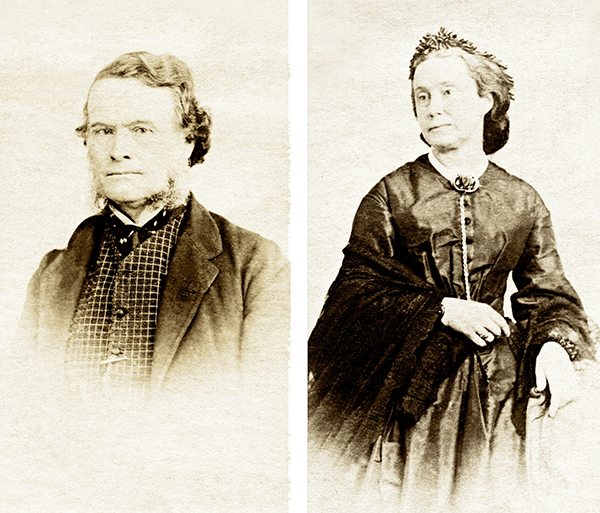
Octavius and Martha Swete née Cummins: Whether Georgiana McCrae introduced Octavius to Martha, or Martha to introduced Octavius to Georgiana is unclear, although there are strong hints that it was the former—but who was Miss Stevens? images The Moxon Brownes
Mr James Cummins had trading links with Melbourne and was presumably familiar with all the mercantile gossip from the new colonies. It seems very unlikely that he would have consented to Martha’s marriage to Octavius, if there were any real grounds for suspecting Octavius’s honesty or business probity, or the circumstances in which he had lost money in New Zealand.
Two children of Octavius’s marriage followed swiftly, Charles GordonThis child was presumably named Charles after his uncle Charles, the Indian Army officer, and Gordon after his uncle Gordon who had died the previous year in New Zealand born on 9 January 1845 and christened on 13 April 1845 at St John’s, Clapham; and Ernest Alfred, born on 12 April 1846, and christened on 31 May 1846 at St Michael’s, Stockwell.
Octavius and Martha seem to have made their first home at 7 Park Grove, in Brixton, close to the Cummins family house in Stockwell. There survives a note to Martha, in Octavius’s hand, dated 21 February 1844, sent by postThe envelope is franked, but has no stamp. It was evidently sent in the expectation of delivery the same day. in an envelope with the wax seal of “City of London Club House”. The note reads:
Don’t wait for me dearest as I may not return till eight perhaps—I shall go straight home but rather suppose I shall find you at [Mayfield] Lodge and shall come after you but not to tea—thine ever O.B.
On the reverse of the note is written Phil.1.3v—a reference to Paul’s Epistle to the Philippians Chapter 1 Verse 3:
I thank God upon every remembrance of you.
However, Octavius and his young family did not tarry long in London. In 1847, when the two children were both under three years of age, Octavius sailed with his family to Melbourne in Australia Felix, now the State of Victoria. Charles BrowneCharles Gordon Browne records that Octavius was sent on behalf of his employers, Messrs Gibbs, “to wind up a concern [in Melbourne] for them”; but the fact that Octavius arranged for his family to accompany him would indicate that the business he went to attend to was thought likely to be protracted, or that this time Octavius had decided to settle in Australia. Be this as it may, as Charles BrowneCharles Gordon Browne records:
Octavius quickly acquired an independent business [in Melbourne] trading chiefly in wool [and] before long became a man of considerable influence in the Colony.
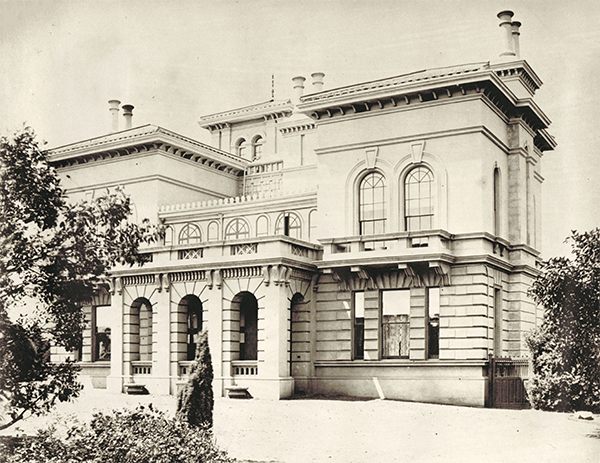
Charnwood Chateaux on the Ground: Built for Octavius in 1853, in St Kilda, Melbourne, although he never lived in it, Charnwood was the climax of the antipodean “chateaux”—castles—that for Octavius, a decade and a half earlier, had “vanished into thin air.” image The Moxon Brownes
The Australian economy received a boost from the discovery of gold in 1851, and there is no doubt that this contributed indirectly to Octavius’s increasing success and prosperity. Georgiana McCrae’s biographer Brenda Niall records that in the early 1850s Georgiana’s son George was set to work as a clerk in Octavius Browne’s shipping agency:
…where he had the delightful duty of going to various Melbourne Banks, where he weighed the gold and watched as it was shovelled into tin boxes; these were then soldered down and placed inside cedar boxes.
Last, with a police escort, he used to march beside the dray to the wharf and personally see to it that every box went on to the deck of the steamer. After the last receipt was signed, there would be a champagne lunch to celebrate the safe arrival of the goldGeorgiana, 210, quoting George Gordon McCrae Experiences not Exploits, Vol 3..
Octavius certainly became very wealthy very quickly, as well as acquiring considerable authority and influence in the mercantile community. It is for example recorded that:
…the Melbourne Chamber of Commerce was formed in the counting house of Octavius Browne on 12th May 1851 … as a society of merchants designed to arbitrate in mercantile disputes and [to] represent Melbourne’s mercantile communitySee eMelbourne The City Past and Present: Melbourne Chamber of Commerce.
Meanwhile Octavius’s family was expanding fast. Adelaide and Fanny Sophia Browne were born in 1847 and 1849 respectively, followed by William MoxonBMB’s great-grandfather. in 1850, Edward Pohlman in 1852, and Gerald Brunet in 1854. All had distinguished local godparents, as befitting Octavius’s new status in the community. These included the state governor, Charles La Trobe, the Bishop of Melbourne, Charles Perry, and a senior judge, Robert PohlmanFor further details see Chapters 12–17 of printed edition.
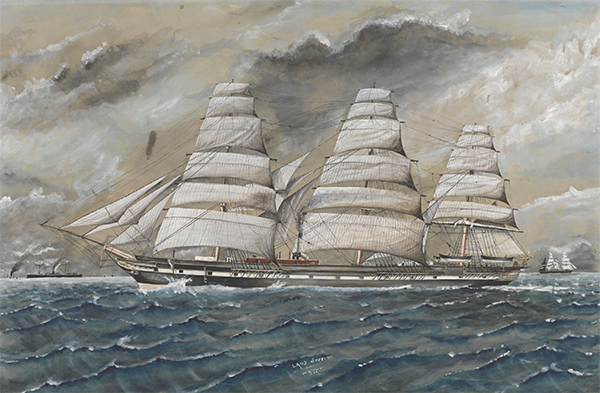
And Back to Sail: Octavius and Martha left Australia in October 1854 on their return voyage to England, sailing with their seven children and two servants on the steam packet Lady Jocelyn, depicted here under full sail. Although built as a steam auxiliary, by the time she became a frequent visitor to Aotearoa—she visited a total of 15 times—her engines had long been dispensed with. watercolour W Gippoer
No doubt to accommodate this increase in numbers, Octavius moved his family into larger accommodation, at Brighton, some six miles from Melbourne, while a magnificent house, known as Charnwood, was being built for him on elevated land at St Kilda, in what was then on the outskirts of the city. This imposing house, with a tower and classical colonnade and many acres of surrounding land, was designed by the Melbourne architect Samuel Jackson, who was inviting tenders for the construction work in May 1851See Melbourne Herald, 22 May 1851. Work was completed at some time in 1852 or 1853, but Octavius and his family never lived in the house. By 1854, Octavius was feeling the effects of over-work on his health and was concerned about the education of his children. Without much evident hesitation, he made the decision to return to England, making over his Melbourne business to his recently arrived younger brother, Edward Decimus, and to his clerk Edward NoyesSee Victoria Government Gazette No. 81 (1 September 1854) at page 1974.
In June 1854 the house at St Kilda’s was sold to a wealthy early colonist, Matthew Hersey, for £30,000 (about £3m in today’s money). Although Octavius never made this house his home, the fact that he was able to commission its construction within just five years of his arrival in Australia, shows how swift his rise to substantial wealth had beenIn a letter to Octavius of 1854, a Sydney artist and friend, Conrad Martens, wrote about some pictures of the outback he had painted for Octavius, finishing his letter “Is it you the papers say are going home with £20,000 a year? I hope it is so, you are just the man who ought to have it”. £20,000 would equal about £2m in modern money. See Letters of Conrad Martens 1834–1878 State Library of New South Wales.
Just before leaving Australia, Octavius sat for the fashionable sculptor Thomas Woolner, who was visiting the Colony to access a new, wealthy clientele for his work. He produced a number of bronze portrait medallions for local Melbourne worthies, including Governor Latrobe, and Octavius Browne. Charles BrowneCharles Gordon Browne records that in 1903 this portrait was hanging in his hall. Its present whereabouts are unknown but is possibly still in the possession of one of Charles BrowneCharles Gordon Browne’s descendants.
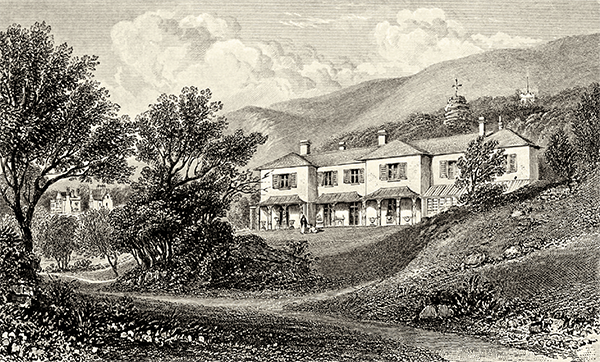
Hotel-Scale Accommodation: Today, boasting beds for up to 22 people, Orchard Leigh, Bonchurch, Isle of Wight, was the first of three hotel-sized accommodations used by the Octavius Browne household, before his death in 1876. image The Moxon Brownes
Octavius and his young family left Melbourne on 1 October 1854 in the Lady Jocelyn, and after what Charles BrowneCharles Gordon Browne (who, travelling at nine years of age, no doubt retained a vivid impression of the trip) describes as “a long and stormy passage round Cape HornThe Lady Jocelyn was a recently built barque with auxiliary steam engines, considered a very commodious and comfortable vessel. Records of the General Screw Steam Shipping Co Ltd show that on Octavius’ trip the Lady Jocelyn was carrying about 100 passengers, and cargo consisting of gold and other goods worth £500,000. The record includes the detail that the ship “fell in with icebergs on the passage round Cape Horn””, landed safely at Southampton on 1 January 1855, after three months at sea.
Charles BrowneCharles Gordon Browne records that initially Octavius and his family lodged with the Cummins family at “Wildecroft” in the village of Betchworth near Dorking. Charles BrowneCharles Gordon Browne comments that “it must have been a tight fit, as the house was a small one, and he added a party of nine besides a servant or two to the three unmarried daughters who were already living [there]”. Before long Octavius and the family moved to a rented house, Orchard Leigh, in Bonchurch, Isle of Wight, then as now a picturesque village near a beachBonchurch was renowned for its literary connections in Victorian times, being visited by Dickens, Stackpole and Swinburne amongst others. Dickens is quoted as remarking that the village was “the prettiest place I ever saw in my life, at home or abroad”. Orchard Leigh is today2019 let for holidays, advertised as capable of accommodating twenty-one people, so the spacious accommodation must have been welcome after the cramped sojourn with the Cummins family. Octavius’s youngest son, Oswald Auchinleck, was born on the Isle of Wight on 14 September 1855.
In 1856 Octavius moved to another rented property, The Greenway, Shurdington, near Cheltenham, which Charles BrowneCharles Gordon Browne describes as “a beautiful old Elizabethan house”. Today it is a popular luxury hotel, with twenty-one guest bedrooms: again, plenty of room for the family, which was still expanding. Octavius’s youngest daughter Octavia Geraldine was born at the The Greenway on 28 January 1858, bringing the immediate family to eleven; and no doubt there were several retainers. Charles BrowneCharles Gordon Browne records that while living at The Greenway, Octavius was “largely instrumental” in the restoration of his local parish church at Badgeworth.
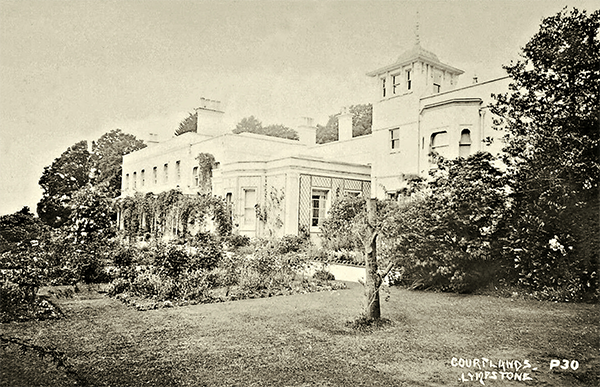
Five-Star Accommodation: Postcard of Courtlands, as Lympstone Manor, Courtlands Lane, Exmouth, was known in the 19th century, and when it was the home of Octavius Browne for the last 14 and a half years of his life. image The Moxon Brownes
In January 1862 Octavius moved to Devon, where he took a long lease of Courtlands, a magnificent house near Lympstone, standing in eighty acres of land overlooking the estuary of the Exe. This was to be Octavius’s last home.
Courtlands had originally been a farmhouse, being effectively rebuilt as an impressive residence for the Baring banking family in the latter part of the 18th century. The house passed through several hands both before and after occupation by Octavius, and is today a five-starred country house hotel and restaurant, complete with celebrity chef and Michelin star.
Charles BrowneCharles Gordon Browne, who lived at Courtlands with the family when not away at school and university, says that in 1864 Octavius’s:
…health failed him, and he spent the winter travelling with his wife in Switzerland and Italy, returning somewhat restored in health, but never again what he had been, in the spring of 1865.
While he was away, the house and, presumably, Octavius’s young family, were supervised by Octavius’s brother Charles, recently retired as a Major General after a lifetime spent in the Indian Army. Charles’s biographer, Richard Dobbs, recalls a letter from his friend Charles about his visit: “… he gave me a lengthy and graphic description of social and religious affairs as he found them, and how he took charge of a brother’s household, who, accompanied by his wife, had been obliged to go to the Continent on account of his health.
This brother had a large establishment, consisting of twenty servants“Twenty servants” may have been a slight exaggeration. The 1871 census shows a housekeeper, two ladies’ maids, two housemaids, a kitchen maid and footman all living in at Courtlands. In addition, there was a butler, and there must also have been a cook, more than one gardener, a groom, stable boy and probably a coachman, all living nearby; how many nephews and nieces there were I cannot tell, but Browne was quite in his element, instructing all in the glorious truths of Revelation in his very interesting and fascinating way. This quiet country life was delightful to himSee “A Brief Sketch” at 112 …
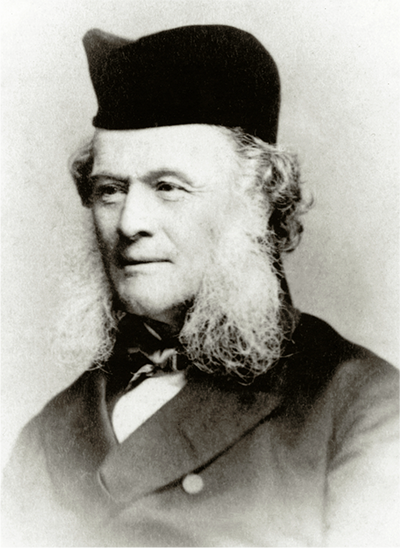
Octavius Browne in Later Life: “…propelled into middle-class wealth and social position on the floodtide of Britain’s imperial expansion in the 19th century.” image The Moxon Brownes
Charles BrowneCharles Gordon Browne describes his father in retirement as:
…of the greatest generosity and the soundest common sense. He never could be persuaded to undertake any public office in his parish or county, while he was always ready to give substantial help to any cause which he considered goodIn his History of the Browne Family, Charles St Denys Moxon says that during his retirement in Devon, Octavius (whom Moxon describes as “a man of great information and experience”) gave much time and attention to the Devon and Exeter Hospital.
In explaining why Octavius retired from his successful business in Australia and returned to England, Charles BrowneCharles Gordon Browne says one of his reasons was “to devote himself to the education of his now large family”. The opportunities for first class education in the Australian colonies were limited in the 1850s, and unless Octavius and his wife were prepared to go for long periods without seeing their children, the whole family’s return to England could have seemed unavoidable for this reason alone. Certainly, the boys were all sent to the best schools: Cheam, then as now a fashionable preparatory school; and Harrow, for all of them except William, who went to Eton. Charles BrowneCharles Gordon Browne completed his education with a degree in classics from Balliol College, Oxford; Ernest went to Trinity Cambridge, as also did William and OswaldThe details of the education received by Octavius’s daughters is not recorded.
Thus from somewhat precarious beginnings, and giving his children the kind of education he had himself been denied, Octavius established himself and his family as impeccably respectable and respected, propelled into middle class wealth and social position on the flood tide of Britain’s imperial expansion in the 19th century.
Octavius died, rather suddenly, on 25 June 1876, at Clifton, Bristol, “while on the way to Scotland for the benefit of his health”. By his willThe administration of Octavius’s will did not go entirely smoothly. He had some undeveloped land in Melbourne which an Australian lawyer Charles Ibbotson was instructed to realise. Ibbotson was dilatory, and died before this task was accomplished. This caused legal problems which were not resolved until the 1890s, amidst a flurry of affidavits filed with the Probate Division of the Supreme Court for the Colony of Victoria. The land in question was said to be worth £1,200, or well over £100,000 in today’s money. It is perhaps an indication of Octavius’ wealth that this asset was effectively overlooked in the years following his death, he left his entire estate to his wife Martha. Less than three weeks before his death Octavius had added a codicil to this will, witnessed by the butler at Courtlands, providing that if Martha predeceased him, his estate should be shared equally between his sons and daughters. It is hard to know why he should have done this. It may have been a reaction to a health scare from which Martha recovered, or perhaps more likely, was an ordinary precaution taken on the advice of lawyers, whom Octavius may have consulted when worried about the possibility of his own impending death.
Octavius was buried at his parish church local to Courtlands, St John in the Wilderness, in the village of Withycombe Raleigh. His widow Martha remained at Courtlands until the death of her daughter Fanny in September 1883, when she sold the house and moved to 42 Princes Square in Bayswater, where she died on Christmas Eve 1893. She was buried with Octavius at St Johns, Withycombe Raleigh.
Martha’s will was proved on 2 March 1894. The value of the estate exceeded £52,000, or about £6.5 million in today’s money. She left different cash amounts to each of her three daughters, with the residue of the estate left in trust for her five sons.
